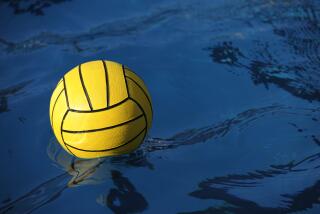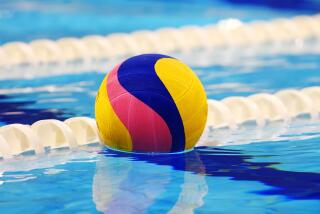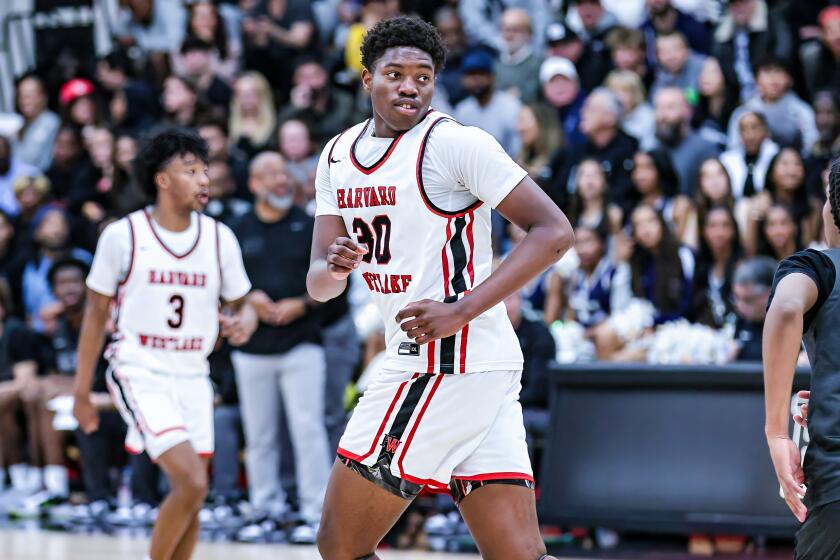Rising Tide
- Share via
Nina Simon knew water polo was for her even before water polo was for girls.
“I love being in the water,” she said. “You get to play with a ball, it’s a team sport and you get to beat up people.”
Simon, captain of the Harvard-Westlake High girls’ team, is a pioneer in a sport sanctioned by the Southern Section in 1996 and that has grown rapidly at the high school and college levels.
A water lover who calls herself “a very bad swimmer,” Simon discovered water polo as a freshman. There wasn’t a girls’ team in those days, so Simon, like dozens of other girls in Southern California, joined the boys’ freshman-sophomore team.
“She was one of the brave ones,” Coach Rich Corso of Harvard-Westlake said.
Simon was among 50 underclassmen who struggled to fit in.
“There was this guy I would guard and he would have my whole [bathing] suit wrapped up and I could never move,” Simon said. “So that wasn’t fun.”
The following year, there was enough interest to prompt the section to add girls’ water polo as an inter-scholastic sport. Fifty-nine schools, including Harvard-Westlake, tested the water.
But some players, like Simon, weren’t sure girls were ready for the physicality of the game.
“At first I was really ambivalent about it because I felt like these girls didn’t want to play with the guys, [so] why now?” Simon said.
But when Simon went from freshman-sophomore scrub to varsity captain in a year, her attitude quickly changed.
“There is such a discrepancy between guys and girls, especially in high school--like in size, strength and speed,” she said. “Among girls, I can really play. Whereas among the guys, I was struggling.”
Girls’ water polo now includes 161 teams in the section and Commissioner Dean Crowley is not surprised by the enormous growth.
Crowley said girls have been competing for club teams for years and this is just an extension of that participation.
“I think for the last five to six years before it was introduced, we had a strong number of girls competing on the boys’ teams,” Crowley said. “It’s just like girls’ golf. There is a lot of interest out there and there is a need for it.”
While interest among Southern Section schools has soared, the same cannot be said in the City Section.
Although 31 of the City’s 49 high schools compete in boys’ and girls’ swimming, boys’ water polo hasn’t been played in the City since the late 1970s.
Apparently, a general lack of interest is the reason.
“To my knowledge, we haven’t gotten any interest from the students to play the sport,” said Barbara Fiege, section commissioner.
However, two years ago, Fiege said she received an inquiry from a conference representative about restoring water polo in the City. But when Fiege responded to the inquiry, she got no response.
Corso, who has been involved with water polo for 27 years, says “it’s not for everybody.”
Water polo’s demanding combination of endless swimming and frequent contact makes it a grueling endeavor for anyone.
The boys’ game has evolved into an exercise of speed, strength and force. In that regard, the girls are just getting their feet wet.
“You watch women’s hoops in the ‘70s and you watch men’s hoops in the ‘70s--big difference,” Corso said. “You don’t have the vertical leap, you don’t have the power even now in the ‘90s, but the [women’s] game has come so far.
“So I’d say we’re kind of like women’s hoops in the ‘70s.”
Jeanine Jackson, who was chosen last month to play on the women’s U.S. Junior National team and scrimmages regularly against boys, agrees.
“It’s a completely different game when you’re playing with the guys,” Jackson said. “They expect you to hold your own. It’s a lot more tactical. Girls have a harder time reading what’s going on.”
Yet, the girls’ game is far from being a tea party.
“I get punched in the face a lot,” Simon said. “I’m in a very physical position guarding [the two-meter player] and I just try to keep my cool and let them go crazy.”
Corso, who coached the 1996 U.S. men’s Olympic team, said girls--at least his girls--are just as physical as the guys.
“With the girls, there is more to grab. And I mean that because of the [bathing] suits,” he said. “For boys, I can’t grab your skin. But if you’ve got that suit there, twist and go.
“In women’s water polo, there is not as much defensive positioning because you can always grab to recover.”
Many refer to the game as basketball in the water.
For Corso’s teams, it’s more physical than that.
“I’ll tell you right now, [most girls] don’t hand check and [defend] like we do here,” he said.
Still, it isn’t the boys’ game, but . . . .
“It’s getting there,” said Wonmeen Jun, women’s coach at Valley College and girls’ coach at Alemany. “At the very highest level, I think it’s close to the physicality [of the men’s game]. But it’s going to take a few more years to get more parity.”
(BEGIN TEXT OF INFOBOX / INFOGRAPHIC)
Just the Facts
Since the Southern Section sanctioned the sport for girls, the number of schools fielding teams has nearly tripled in three years. Here’s a look:
GROWTH CHART
Year: 1996-97
Teams; 59
Year: 1997-98
Teams: 108
Year: 1998-99
Teams: 161
Jumping In
Teams from the region in italic
CHANNEL LEAGUE
Buena
Dos Pueblos
San Marcos
Santa Barbara
Ventura
FRONTIER LEAGUE
Calabasas
Malibu
Nordhoff
Oxnard
Rio Mesa
Santa Paula
MARMONTE LEAGUE
Agoura
Newbury Park
Royal
Thousand Oaks
Westlake
MISSION LEAGUE
Alemany
Harvard-Westlake
La Canada
Louisville
Marymount
Notre Dame
PACIFIC LEAGUE
Arcadia
Crescenta Valley
Glendale
Hoover
Muir
Pasadena
OTHERS
Burroughs-Almont League
Flintridge Prep-Prep League
More to Read
Get our high school sports newsletter
Prep Rally is devoted to the SoCal high school sports experience, bringing you scores, stories and a behind-the-scenes look at what makes prep sports so popular.
You may occasionally receive promotional content from the Los Angeles Times.





